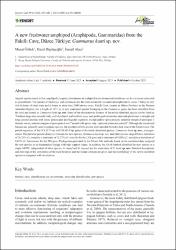A new freshwater amphipod (Amphipoda, Gammaridae) from the Fakıllı Cave, Düzce Türkiye: Gammarus kunti sp. nov.
Künye
Özbek, M., Baytaşoğlu, H. & Aksu, İ. (2023). A new freshwater amphipod (Amphipoda, Gammaridae) from the Fakıllı Cave, Düzce Türkiye: Gammarus kunti sp. nov.. Zoosystematics and Evolution, 99(2),473-487. http://doi.org/10.3897/zse.99.108048Özet
Aquatic species (such as fish, amphipods, isopods, hirudineans etc.) adapted to environmental conditions can live in caves connected to groundwater. The species of Niphargus and Gammarus are the most commonly encountered amphipods in caves. Türkiye is very rich in terms of karst areas and is home to more than 2000 known caves. Fakıllı Cave, located in Düzce Province in the Western Anatolian Region, has a length of 1071 m. A new amphipod species belonging to the Gammarus genus has been identified from the cave and named as Gammarus kunti sp. nov. Some of the characteristic features of the newly-identified species can be listed as “Medium-large size; smooth body, well-developed and reniform eyes; non-prolonged extremities; antennal gland cone is straight and long; second antenna with setose peduncular and flagellar segments; medial palmar spine present; posterior margin of pereopod 3 densely setose; anterior margins of pereopods 6 and 7 armed with spines only; epimeral plates not pointed”. Although the mentioned features are generally seen in epigean species, the members of this species were sampled from the dark zone of the Fakıllı Cave. The partial sequences of the COI (573 bp) and 28S (914 bp) genes of the newly-described species, Gammarus kunti sp. nov., were generated. The pairwise genetic distances between the new species, Gammarus kunti sp. nov. and other species ranged from a minimum of 16.23% (G. tumaf) to a maximum of 28.27% (G. roeselii) for the COI gene and a minimum of 0.88% (G. tumaf) to a maximum of 6.81% (G. balcanicus) for the 28S gene. Phylogenies generated by the NJ and ML methods, based on the combined data, assigned the new species as an independent lineage with high support values. In addition, the ASAP method identified the new species as a single MOTU independent of other species. G. tumaf and G. baysali are the sister taxa of G. kunti sp. nov. Detailed descriptions and drawings of the extremities of the male holotype and the female allotype are given and the morphology of the newly-identified species is compared with its relatives.


















